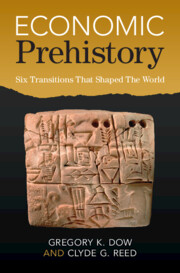Book contents
- Economic Prehistory
- Economic Prehistory
- Copyright page
- Dedication
- Contents
- Figures
- Tables
- Preface
- Acknowledgments
- Abbreviations
- Part I Prologue
- Part II Sedentism and Agriculture
- 3 The Upper Paleolithic
- 4 The Transition to Sedentism
- 5 The Transition to Agriculture
- Part III Inequality and Warfare
- Part IV Cities and States
- Part V Epilogue
- References
- Author Index (Abridged)
- Subject Index
4 - The Transition to Sedentism
from Part II - Sedentism and Agriculture
Published online by Cambridge University Press: 10 February 2023
- Economic Prehistory
- Economic Prehistory
- Copyright page
- Dedication
- Contents
- Figures
- Tables
- Preface
- Acknowledgments
- Abbreviations
- Part I Prologue
- Part II Sedentism and Agriculture
- 3 The Upper Paleolithic
- 4 The Transition to Sedentism
- 5 The Transition to Agriculture
- Part III Inequality and Warfare
- Part IV Cities and States
- Part V Epilogue
- References
- Author Index (Abridged)
- Subject Index
Summary
We build on the model of Chapter 3 to explain how sedentism could have developed in response to better climate conditions involving higher means and lower variances for temperature and rainfall. Sedentism is defined to mean a willingness of human populations to stay at the same site for multiple generations despite occasional periods of low productivity in relation to other sites. We identify three causal channels leading to sedentism. First, there is a short-run channel where climate improvement leads agents to remain at sites when weather there is temporarily bad, because when conditions are harsh, they are less harsh than they were under the previous climate regime. Second, there is a long-run channel where better climate leads to higher regional population. This causes some people to remain at sites where weather is temporarily bad because sites with good weather are now more heavily occupied than before. Finally, there is a very-long-run channel where higher regional population leads to the use of previously latent resources and technological innovation. These mechanisms help to explain the rise of large sedentary communities in southwest Asia during the Epi-Paleolithic and in Japan during the early Holocene.
Keywords
- Type
- Chapter
- Information
- Economic PrehistorySix Transitions That Shaped The World, pp. 110 - 156Publisher: Cambridge University PressPrint publication year: 2023

